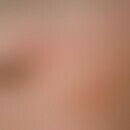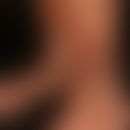Synonym(s)
DefinitionThis section has been translated automatically.
Clinical classification of actinic keratoses (varies according to Olsen)
The clinical appearance of actinic keratosis is manifold. For the clinical classification, the classification according to Olsen (Olsen grade I to III) has become generally accepted (see also histological classification under KIN)
- Olsen Grade I: Early actinic keratoses appear as single or few, differently sized (from 0.1-0.3-5.0 cm in size, rough, blurred, less visible than palpable (palpable on the roughness of the surface), red, rough spots or very flat, non-edged plaques which reach into the reddish colour and are easier to feel than to see (Olsen Grade I).
- Olsen grade II describes advanced actinic keratoses as clearly visible and palpable, flat and irregularly raised, with sharp or blurred boundaries, red, rough keratinized surface. If the surface is more strongly keratinized, the actinic keratosis can also be white, yellow or light brown. After scratching effects (frequently), a black or blue-black shade may appear (older bleeding).
- Olsen grade III denotes "late" actinic keratoses that have existed for a longer period of time and are firmly anchored on the lower surface, with an irregular, humpy surface, also wart-like and of different colours (white, brown, black). When the horn deposits are removed, an erosive subsurface is formed.
Note(s)This section has been translated automatically.
Another clinically evaluable score is the AKASI (acronym for "actinic keratosis area and severity index"). The AKASI score is a well-evaluated "scoring" index for the quantitative and qualitative assessment of actinic keratoses on the head. The aim of this score is to enable an individual risk stratification of patients with actinic keratoses by means of easily ascertainable clinical data (Dirschka T et al. 2017).
LiteratureThis section has been translated automatically.
Dirschka T et al (2017) A proposed scoring system for assessing the severity of actinic keratosis on the head: actinic keratosis area and severity index. J Eur Acad Dermatol Venereol 31:1295-1302
- Olsen EA et al (1991) A double-blind, vehicle-controlled study evaluating masoprocol cream in the treatment of actinic keratoses on the head and neck. J Am Acad Dermatol 24:738-743



